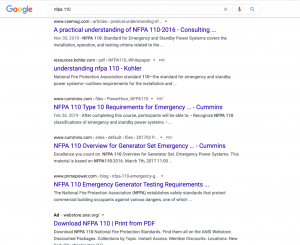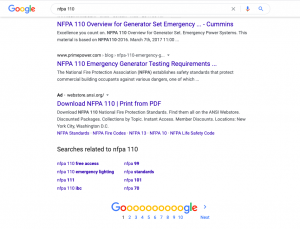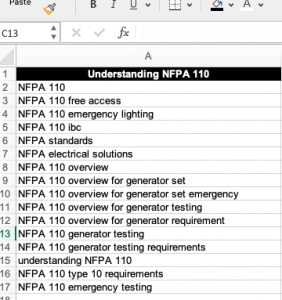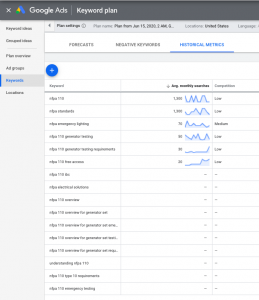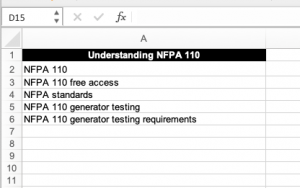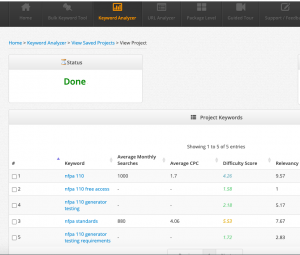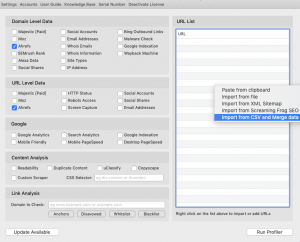One of the biggest drivers for SEO (search engine optimization) on your website is having content that answers the questions your prospective customers are looking up on search engines – such as Google.
But how do you figure out what to write about and what are people even asking? And when you get your list of topics, how do you optimize the content so it shows up in search results?
Performing keyword research will help answer these questions.
Backlinko.com states that “Keyword research is the process of finding words and phrases (aka “keywords”) that people use in search engines in order to optimize content around and rank for those terms in search engines.”
Simply put, what are the phrases that your customers are using online to find products and/or services provided by your company and your competitors. The important thing to remember is that they could be different than what you are used to calling them.
Adding these keywords to your content will help drive organic traffic to your website.
Step 1: Discover your content triggers
The best place to start is by paying close attention during conversations with prospective and current customers. What questions do you find yourself answering over and over again?
Reading They Ask, You Answer by Marcus Sheridan will power you with an outline of how to figure out what your audience wants to learn about. This book is a company favorite and was recently featured on our summer reading list.
Here’s how Sheridan summarizes how to discover the questions that your prospects want answered:
“Have a brainstorm session – Brainstorm every question you’ve ever been asked by a prospect or a customer. Focus on his or her fears, issues, concerns, and worries. State them on paper exactly as the consumer would ask (or search) them, not the way you (as the business) would state them. Once you’ve completed your list, you have the foundation for your entire digital marketing editorial calendar – be it articles, videos, and so on – to put on your company website.”
Each one of those questions could become something that you write about on your website – this is what we like to call a content trigger. In this article, we walk you through our process for discovering content triggers and how to translate them into content marketing ideas. At the end of the article, you can download our content planning worksheet to help keep all of your ideas organized.
Step 2: Prioritize your content topics
Okay, now you have a long list of topics that you want to write about. How do you know which one you should start with?
There are different things to consider based on your company, topic ideas and website.
Which topics do you have the capability to write about right away vs. which ones need more thorough research? Do you need to interview subject matter experts with busy schedules? Do you need to get approval to mention specific a customer or product line?
All of those things could hold up the process of getting the article published. It is always good to interview subject matter experts for any piece, but if you can’t get on their schedule for a couple of months, it might be good to start with topics that you know would be quicker to knock out.
Our suggestion is to pick several topics that you think will really resonate with your audience to do a more in-depth analysis.
Looking at data in Google Search Console will show you what keywords your website already ranks for. Under the ‘performance’ section, there are options to view your current keyword and page rankings. You can see where your website ranks in SERPs (search engine results pages) for specific keywords by looking at the average positions. First page rankings will be anything from 1-10, second page rankings will be anything from 11-20 and so on.
Best case scenario – you find a topic that you aren’t ranking for yet but have the potential to.
But if you are ranking on the second page or after for the keyword – this is good too! Writing a new content piece (or updating an old one) on that topic could bump your ranking to a higher position on Google. This is beneficial because websites typically receive more clicks with improved rankings.
If you are already on the first page, you may want to deprioritize that topic. The return on the investment in Google rankings isn’t going to be as high as the previous two scenarios.
Step 3: Make a list of your keyword options
In the next step, you will need to figure out if are short-tail or long-tail keywords that you can use to target the content to optimize for search engines. You won’t be able to keyword target an article that nobody is searching for on Google.
The easiest way to explain how to find this out is to walk through an example.
“Understanding NFPA 110 regulations” is a topic that we wanted to create a thought leadership piece for our client CK Power.
Use Google to your advantage to determine what people are searching for. Type in the most relevant word or phrase for your topic – in this case, I used “NFPA 110”.
There are a few things to look for in the search:
What are other search terms that Google auto-populates in the search bar?
What are other related terms that are listed in the SERP titles and/or descriptions?
For example, “NFPA 110 emergency generator testing requirements” from the last result would be good to add to the list.
What comes up in the ‘searches related to NFPA 110’ section at the bottom of SERP?
These are typically similar or identical to what Google auto-populates in the search bar. It is just another way to manually sift through the results.
All of these phrases are commonly searched alongside ‘NFPA 110’. I made a list of the ones that were relevant to the topic to start my keyword research base.
There are also tools that will give you more insight into the keywords that you want to target and suggestions for additional ones.
- Moz keyword explorer: Monthly volume, keyword suggestions and SERP analysis
- Ahrefs keyword explorer: Keyword difficulty, search volume, clicks (organic vs paid), keyword ideas and SERP overview
- Google keyword planner: Keyword suggestions by using the ‘discover new keywords’ section
- Google trends: Keyword interest over time, related topics and queries
You can get deep in the weeds here very quickly by digging into every piece of information until you have exhausted all of your options, but you can always go back and repeat this process if needed. Once you have a solid list you can move on to looking up monthly search volume for the keyword list.
The same tools listed above will give you an estimated monthly search volume. But it is likely that they all are going to be a little different.
For example, these are the results for ‘NFPA 110’:
- Google keyword planner: 1,300 searches per month
- Moz keyword explorer: 200-500 searches per month
- Ahrefs keyword explorer: 900 searches per month
I tend to lean towards using Google keyword planner because it is what I feel comfortable with. However, it has been researched that Keyword Planner will occasionally group like search terms together and that may inflate the search volume numbers.
After using Google’s keyword planner tool, it looks like ‘NFPA 110’, ‘NFPA standards’, ‘NFPA 110 generator testing’, ‘NFPA generator testing requirements’ and ‘NFPA 110 free access’ could be viable options to use in this content piece.
In the next step, we will look at how your website stacks up against other websites also creating content around this topic.
Side note: If users aren’t searching for your topic, it could be because the topic isn’t broad enough or they don’t know the solution/product exists. This doesn’t mean the content shouldn’t be created if you think your prospects will find it valuable, but maybe it should be used in an account-based marketing campaign or another direct approach.
Step 4: Determine the viability of your keywords
After cleaning up the keyword list, here is where we are at:
How competitive are those keywords? Are there a lot of other websites covering those topics? Are those websites more authoritative than your website?
To get the list of websites that are ranking on the first page of Google, I like to use the keyword analyzer tool in Term Explorer
Now, I need to determine how CK Power’s website stacks up against the ones on the list from Term Explorer. By using a tool like URL Profiler, I can easily compare website domain authority. To compile the domain authority data, we have our URL Profiler account linked to our Ahrefs account. But as you can see in the image, you can use Majestic, Moz, SEMrush and more.
To compare website authority, I need to know what my client’s website domain rating is. This will vary slightly depending on which the tool (Ahrefs/Moz/Majestic/etc) is used. After sorting the sheet by domain ratings, I look to see where the website will fit in. If the rating is better than or close in rankings to the rest of the list there is potential that after time the new content piece could replace ones listed.
Comparing monthly search volume and competitiveness of keywords for all of your content ideas will help you paint a clear picture of which topic (or a few topics) is your best bet to start with.
Step 5: Create your content
Finally, you settled on your content topic and keyword/s! Now you just have to write the content.
It is important to remember to put yourself in your prospect’s place when writing content. Would you want to read an article that goes on and on about how great a company is? Or would you rather read an article that outlines the problems you are experiencing and gives realistic advice on steps to solve them?
Learn how to extract knowledge from subject matter experts and then translate it into helpful content that your prospects want to read.
Side note: Once your content is published it won’t automatically start ranking on Google. There is no magic trick to speed up this process. It will take time post-publication for Google to recognize the article and bring it into the SERPs. The best secret to ranking in Google is to consistently create good content that people want to read.
Need more help? We have a variety of services that can help you with your marketing strategy.


